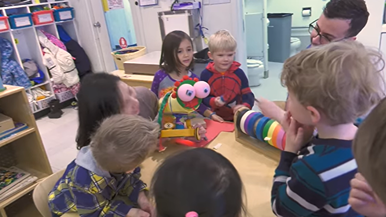Preschool Robotics?! Why Preschoolers Should Learn to Code
Coding is a new literacy. We teach children to read and write because it opens new doors for them, gives them new ways to think about the world and offers new ways to express themselves. The same is true for coding. Introducing preschool robotics introduces your young learners to playful computational thinking.
When we learn to code, we learn to think sequentially, to think logically, to solve problems. And most importantly, we gain the ability to create anything we can dream of.

While it would be wonderful if more children grew up to fill the void of scientists and engineers, that’s not the only reason STEM literacy is vital. We don’t teach young children to write so that they will all become professional journalists and novelists. We teach them to write so they can create a shopping list, draft a business plan, share a love note.
KinderLab Robotics co-founder Dr. Marina Umaschi Bers states, “We want computer programming to reach everyone, starting with young kids. We think of coding as a literacy – to understand how the world works. Just like reading and writing. Reading and writing is not just so you can become a professional journalist or novelist. Some of us will, most of us will not. The same is true for coding. Some of us will become software engineers or programmers, but most of us will not. We want to learn how to code anyway to so you can manipulate and understand what is going on around us so we can really think in abstract, problem solving, creative ways.”
Learn about the importance of introducing preschool robotics. Even the youngest students can learn coding in a fun, engaging, hands-on way.
If we don’t start encouraging coding when children are young, we’re missing an opportunity. By fourth grade, stereotypes surrounding those who aren’t good at math, science, technology and engineering (STEM) are already formed. So why do most of our STEM and robotics programs begin in middle and high school? Why aren’t we starting early, when children are curious about the world and open to learning new things?
Of course, it is easier said than done. We need technologies that are developmentally-appropriate. Technologies that allow children to learn through creativity and open-ended play. That where KIBO comes in. KIBO offers preschool robotics through early elementary school. KIBO is screen-free and uses familiar wooden blocks to build a sequence, with a customizable art platform to teach children, teachers and parents the fundamentals of programming in a fun and engaging way.
Research shows early exposure to KIBO coding and robotics brings:
- Improved Sequencing Ability in Early Childhood
- Improved Computational Thinking with Concrete Tools
- Counteracting Harmful Gender-Based STEM Stereotypes
- Positive Impact on Underrepresented Groups in STEM Fields
Read more about KIBO and how easy it is to introduce coding to young children in this video from Idaho STEM Action Center, Integrating Technology in a Preschool Classroom.
Bring preschool robotics into your early learning center and watch your little learners become independent, critical thinkers that draw their own conclusions, go through the steps of the engineering design process, and learn to communicate and collaborate – leading to greater achievement and self-esteem.




















